How cordovan is made, at Horween tannery, Chicago
Why should you care about a factory visit?
Why care what the place is like where something is made - compared to say, the quality of it or how to wear it?
Does it matter whether the place is clean or dirty, old or new? What the atmosphere is like, or the smell?
Personally, the reason I like visiting factories is it gives me a deeper connection to the product. It’s an emotional, personal thing.
And it’s nice to write articles about them to try and communicate that feeling to readers. So they can sense that greater appreciation as well.
There’s usually a moment in a factory tour when this feeling hits home.
More often than not, it’s when the thing you’ve been watching all the way through its manufacture starts to resemble the product you love.
At the Horween tannery in Chicago, that point was on the top floor, when a metal cylinder was rolled with surprising speed and force over the leather, by a mechanical arm (below).
Most of the processes around the rest of the factory are slower.
Skins hanging in dark-black pits, being gently agitated; their top layers being smoothly shaved off.
But this glazing arm moves with real aggression. The kind of power that makes you wonder about the brutal impact of being hit with it.
The result, though, is lovely.
The cylinder gives the cordovan shell (not of course the skin of a horse, but a membrane sitting underneath it) its distinctive, rich glow - the lustre that many men love recreating as they rub cream into their cordovan shoes.
And the batch I was watching was colour number 8, that dark red that has particular depth, and is the most popular (around 65% of sales).
It was that process, and the transformation it wrought on the leather, that made me think of my full-strap penny loafers at home.
And now at home, it lends an emotional depth to the shoes when I wear them.
The Horween tannery as a whole is old, wooden and full of character.
There are four floors, with the process moving from skin to finished product as you travel upwards. In the basement are the cement-mixer sized drums, which were so big they had to knock down part of the wall to get them in.
And next door, stacks of salted skins - flesh with hair attached, not for the faint hearted.
(Though animal lovers, note that all the cordovan is a bi-product of the horse meat industry in Quebec, France and Belgium. Not what you’d expect, perhaps, if you don’t eat horse; and not ideal for the tannery either, as supplies can be erratic.)
Around the corner are the tanning pits. This is the image you will expect if you’ve ever read about or seen images of tanneries.
The skins are attached to wooden slats, packed closely together, and hung into a tanning mixture of various barks.
Every now and again an automated mechanism lifts the whole lot and drops them again - rotating the liquid.
The smell down there, by the way, is horrible. Acrid. I thought the association of tanneries with bad smell came from the times excrement was used - but actually even just fermenting bark will do it.
I love places like this for the patina on everything.
The wooden barrels where the grain has been worn smooth by human hands. The floor in the basement where years of run-off has actually carved an estuary-like pattern in the concrete (shown top).
And of course the piles of cordovan themselves make lovely colours and textures everywhere.
Cordovan is actually a minority of Horween’s business - it makes up roughly 15% - but it is what they’re most famous for.
In the US, they’re also known for producing the leather of all official American footballs, and basketballs too. The leather is printed with a pattern to help grip on the ball, as well as the occasional ‘W’ for Wilson, to show its authenticity.
The factory has been on this site for almost a century, having been established in 1905 and moved to the site in 1920.
Tanneries are nearly always on the edge of town (see point earlier re smell), and in fact the road Horween is on is called ‘Ashland Avenue’, after the stacks of ash that were pushed to the edge of town after the great fire in 1871.
But Chicago has expanded a lot since then, and now Horween is oddly close to the centre. It’s only a 10-minute drive from Leffot or Optimo downtown.
This has led to discussions over the years of the tannery moving. But if it ever did, the City would have to pay for it and the cost would be extraordinary. In all likelihood it would be cheaper to build an entirely new tannery.
On the top floor of the building are the offices of Horween management: Arnold ‘Skip’ Horween and his son Nick.
Nick is the fifth generation. He has racks of boots in his office, and shows me a new collaboration for a motorcycle boot in full cordovan. It will be a pretty tough piece.
On the wall outside are leather skins tacked to the wall, where visitors can write their names and well wishes.
Like many things at Horween, time has taken over and the skins now cover two walls and part of the ceiling.
I have an emotional response, seeing my name scribbled there and remembering that shine coming up on a cordovan butt.
I hope I’ve communicated just a little bit of that emotion to you.


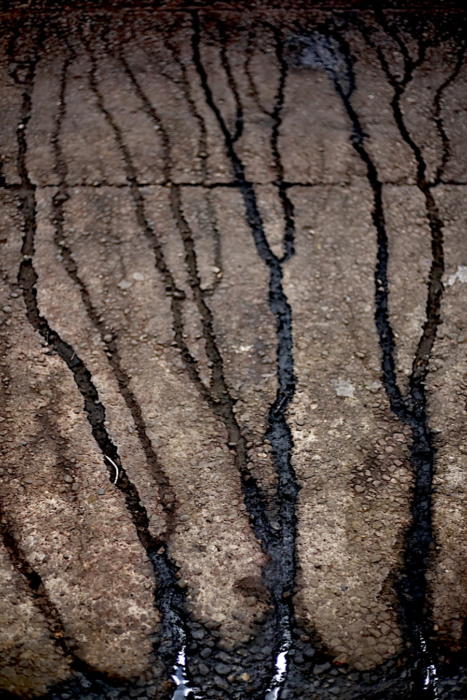
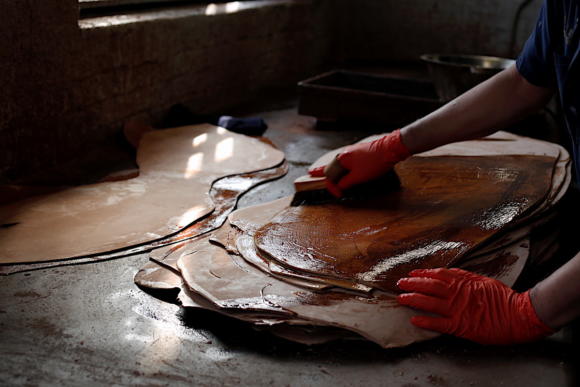
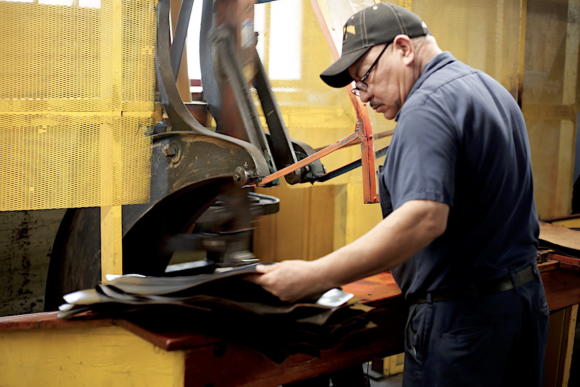
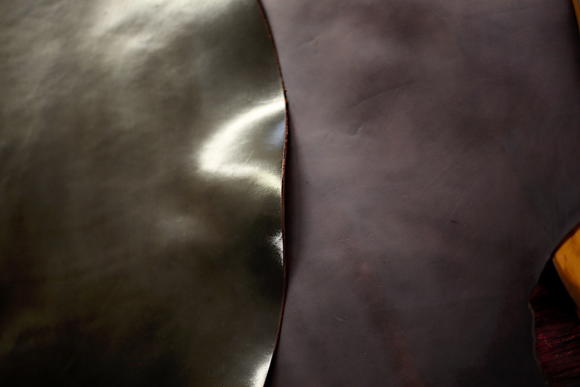
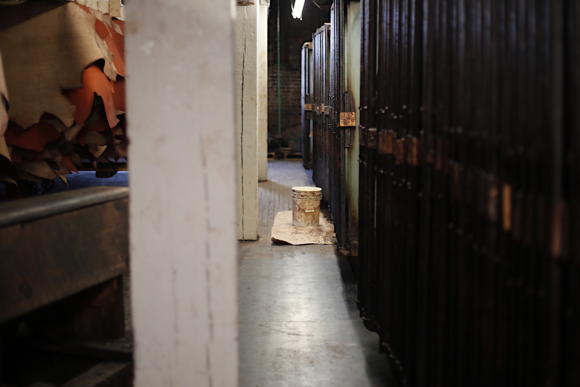

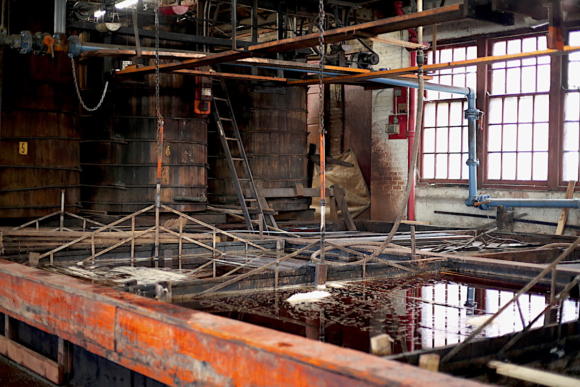

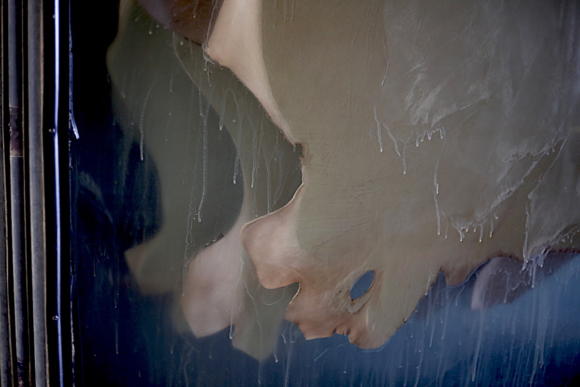
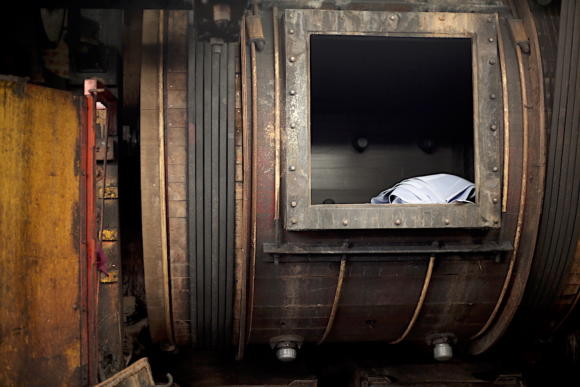
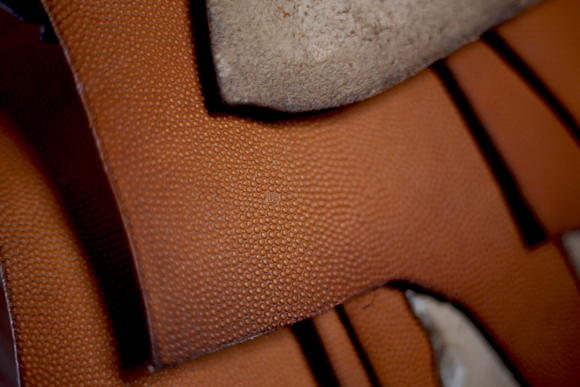
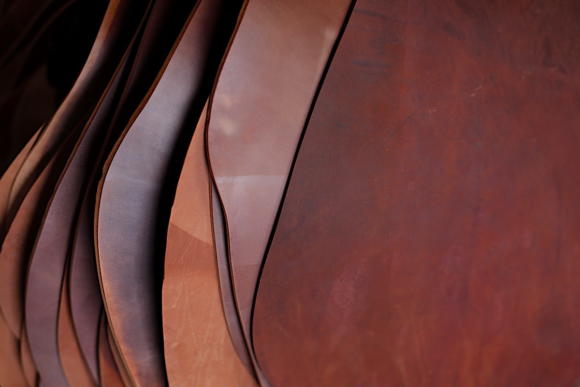
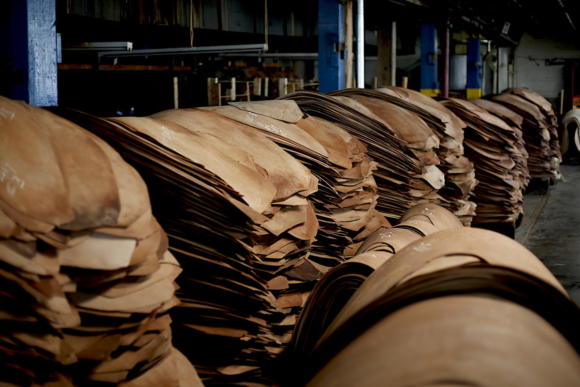
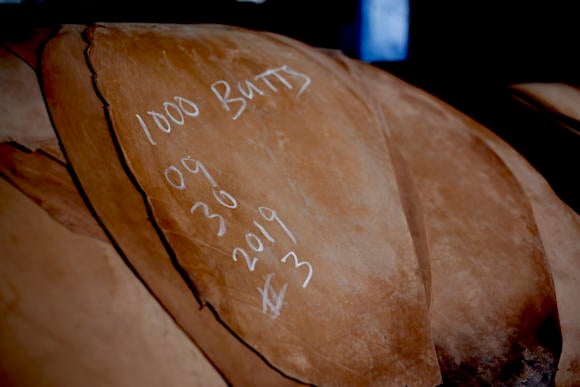
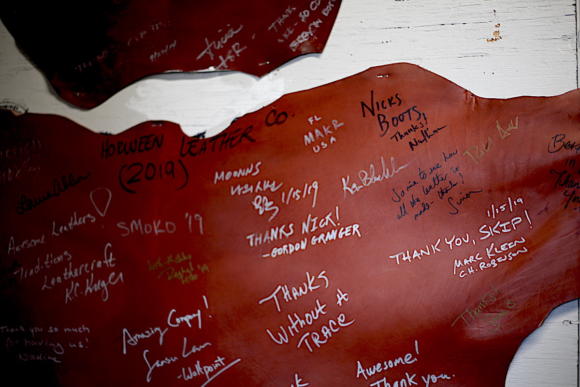


























It’s a post like this that makes a guy shelve their designs on a new pair of split-toe, suede derbies and stump up the extra 200 on a pair of lovely cordovan tassels.
Always a delight to take a look at characterfully worn through factory like Horween, it really adds a certain romance to the narrative of the finished article.
That was my thought exactly. Even though I’m not a big fan of cordovan as a leather, the article made me want to go out and buy a pair. Brilliant writing!
Hear hear
Simon,
Evocative article, I like it. I don’t think you’ve written much about cordovan shoes (at leas that I can see) – any particular reason?
I love the lustre of the material do find them a pain to deal with personally – the chunkiness and weight gives the assumption they’ll be good for all weather, but they can easily get in a bit of state when worn in rain.
Good point Sam, no I’ve never written much. I’ll plan something
Dear Sam and Simon,
Cordovan doesn’t need to be babied nearly so much as some think. Have you seen the letters from General Pershing looking for Cordovan boots while in France in WWI?
The link is from Ashland leather, which is run by two Horween employees, btw
-hugh
Chicago
The link doesn’t seem to have been posted –
https://ashlandleather.com/blogs/inside-ashland/general-pershings-100-year-old-letter
-hugh
I hope that the next time you go to Chicago you’ll schedule a visit to the Oxxford factory and write a piece on the clothing.
Reading your evocative article reminds me of the time I visited J&FJ Baker the last oak bark tannery in the UK. A great family business. Indeed the smell is something to behold…
It’s impressive isn’t it? You wouldn’t think just bark and skin could produce that.
I have a pair of Alden Cordovan Loafers which I purchased (invested) in January 1982 and which I still wear today.
Simon, great read and timely for me. I’ve been toying with jumping on the cordovan band wagon. The thing that’s put me off is the shine. I can’t help feel that it’s smooth surface limits it’s ability to be worn with jeans. Thoughts? Where would be put it on the formality scale? Above or below suede?
It’s interesting, it used to be considered a smart leather, but is.now seen as more casual largely because of the styles and lasts it’s made in (eg Alden, not dressier makers)
I’d put it as more formal than suede, purely on material, but in reality most cordovan shoes are less formal than a lot of suede ones
Simon,
Could you expound on that (I am imaging your sliding scales of formality)? Imagine same last, same design: would you say calf->cordovan->suede?
Yes. Colour would also make some difference too of course
At the risk of appearing a hypocrite I do eat meat,wear shoes made from leather, and clothing made from calf,lamb,sheep,etc skins.
However as an equestrian who has had many long term equine companions,I find the consumption of horse meat and the use of their skins for fashion repulsive.
I feel that companion animals such as horses,dogs,cats etc should be exempt from such uses. Would you feel comfortable using your children’s cat skins to line gloves..or perhaps a dog fur collar. I am not a member of PETA..I am not someone hysterically against the use of animal products. I just feel that certain species of companion animals be exempt from the trends of fashion.
Interesting. I understand the view, yet it feels arbitrary doesn’t it?
I mostly agree with Anon and I don’t think it is that arbitrary. Cows are very different than horses, and–perhaps more importantly–they are very different to us. A cow is a different thing to me than a horse is to me. The difference may not be as great as the difference between a spider and a dog, but there is a difference.
As Anon points out, I think companionship is a big part of how horses are different to us. It feels weird to eat or otherwise use the dead bodies of animals that are our companions. It feels callous and insensitive and I question the effects on us of treating companion animals like so. It probably makes us more callous and less sensitive.
We share in something with animals that are our companions. They are our companions and friends. Their interests, to some extent, become our interests (we want to see, for instance, that our dogs are happy) and their interests are ours (they often like to see us happy). Furthermore, we share in activities with companion animals. People partake in activities with their dogs and horses. This is particularly significant because there is something cooperative in a shared activity: in cooperative activities our desires are pointed in the same direction.
We don’t share in very much with cows. Very few humans find companionship with cows. Very few humans engage in activities with cows. Very few cows have relationships with humans. There may be internal, biological reasons for this (such as intelligence) but there also may not be. We don’t need to defer to scientific criteria to explain companionship.
Also, if you still think it is arbitrary, let me ask you the following question: do you think it is arbitrary that we don’t think it is okay to wear human leather, but we do think it is okay to wear cow leather? That doesn’t seem arbitrary to me and neither does this.
I don’t mean that it is arbitrary that we treat companion animals differently. I meant that it is a little arbitrary (perhaps, culturally specific) which animals we consider companions. It’s not directly related to intelligence or ability to express emotion, for example.
I would also think it would be interesting to hear from someone on the opposite view, for example from a culture that sees no problem using horses or dogs, or that considers different animals as companions.
I believe Simon hit the nail on the head. Pigs are perhaps the most intelligent land animal that is associated with humanity. Yet western cultures generally have no issues eating its’ flesh. Some cultures view it as unclean, etc.
Dolphins (and Whales) may be the most intelligent of all, but are hunted for food by some cultures.
Some Asian cultures view dogs as both companion and a source of meat
The short answer is there is no inherent “value” for an animal as a companion, or source of meat, etc., beyond what we as humans have projected upon them.
am i correct to say cats and dogs were domesticated, so they were ‘forced’ to become humans companion. they had no choice. im sure you can domesticate pigs, sheeps and cows too so i dont think you should exclude certain animals from trends of fashion
I think it’s important to recognize that one’s specific culture and society has an obvious influence on such attitudes. In Korea, dog meat is consumed by people as a matter of course, and in India, devout Hindus are repelled by the very idea of consuming beef. I believe our gut reactions to such things are quite heavily conditioned by our society and upbringing. But I am in agreement with the view that one’s personal preferences must be in tune with that upbringing, simply to make life easier! However, one can sometimes decide to overcome these strictures and engage in a formerly forbidden practice, as when someone brought up as a Hindu decides to eat beef after moving to a Western country. In sum, your comfort level with a specific practice is central to your decision to engage in it. I eat most meats, but would have a difficult time consuming either horse meat or dog meat, for reasons similar to the one Anon writes about.
In Switzerland are both butcher shops specializing in horse meat not possible with customers as well as many kinds of horse races not possible without riders and stalls. But no cordovan manufacture to my knowledge.
This opens a question I’ve been debating for a while, but haven’t found an answer. As an equestrian lover as well, I wonder if horween cordovan is somewhat ethically sourced. In example the shell is just a byproduct of other industry, either race horses or similar, and is it a resource that if no longer used would go to waste? I would find that if the later, I wouldn’t have a problem wearing cordovan.
Some of it is sourced from places where horse is still consumed as meat, for example in parts of Canada
Lovely article, Simon, one of your recent best. I hardly ever get to Chicago, but next time I do, I’ll try to visit the tannery.
Lovely article, and totaly agree on the emotional bonds created by seeing the making of a product this Wayne.
Personally not a big fan of cordovan, though I have a few pairs, the oldest being a pair of Alden split toes in #8 now approaching 20 years. As with all quality leathers being well maintained, they look better now than when new.
Again, great article, made me want to wear those old ones tomorrow.
I didn’t write the previous comment re. sympathy for ‘companion animals’ but generally agree with the sentiments, and no it’s not arbitrary. Why not? It’s actually hard to define if you haven’t spent some time with them and realise the quiet, intrinsic value that they have. After 5,000 of service and domestication, as beast of burden, ride, coach horse, artillery team (one estimate has it that 6,000,000 were used in WW1), fire appliance, dray, delivery team etc. I figure we owe them a little more than using them, when dead, as shoes. No other livestock animal has the same personality, curiosity, power or grace. The motivating force of history, from the classical age of antiquity to the internal combustion engine, has been enabled by the work of the horse (peak numbers were 3,000,000 in Victorian Britain) we still rate engines in horse power…. For the many who haven’t grown up with animals or in a rural area it’s an understanding easily missed. From a more selfish perspective, it’s not so much what the horse is but what civilisation achieved and how we progressed with it that makes it important and gives it nobility, no other animal has been a better servant. What people wish to wear is over to them but I think it reasonable to inform any discussion as to why, for some, using horse in fashion is not a choice they wish to make.
https://en.m.wikipedia.org/wiki/Horses_in_the_United_States
https://en.m.wikipedia.org/wiki/Horses_in_World_War_I
https://en.m.wikipedia.org/wiki/History_of_the_horse_in_Britain
https://en.m.wikipedia.org/wiki/Horses_in_warfare
Thank you, very interesting.
Purely playing devil’s advocate here, I think it’s also interesting how some people and cultures considering it ‘honouring’ the animal more to use every single part of it – meat, bones, hide etc. If these animal skins are just going to be thrown away or burnt anyway, I can see the argument that it’s better to use them in something that will be highly valued.
This hits the nail on the head. Horses are dear to my heart, let’s use every bit. I love my Alden cordovan boots and will have them for my lifetime, and I thank the gorgeous beast they came from. I will care for them meticulously, they will undoubtedly outlive me.
I have to commend you on such a wonderfully written article! You’ve made this factory my number one visit when I move to Chicago in thirteen months.
Cultures that ‘honour’ the death of an animal through full utilisation are often those driven by absolute necessity. An example would be the relationship between indigenous Americans (aka Plains Indians) and buffalo. Most importantly the fundamental use was as the fundamental food staple. The ‘value’ you attach to footwear use is therefore monetary and extrinsic and each shell produces only one pair of shoes. Philosophically it is attached to a world view that sees all of nature as disposable through commercial utilisation. Interestingly US based Horween source the skins from Canadian specialist horse slaughter houses which in the US are illegal due to animal welfare concerns and a moral rejection of the industry.
https://www.cbsnews.com/news/horse-slaughter-banned-in-us/
https://eu.usatoday.com/story/news/politics/2018/03/26/ban-slaughtering-horses-meat-gets-last-minute-renewal-spending-law-trump-signed/459076002/
https://www.aspca.org/animal-cruelty/horse-slaughter
Thanks, and nice links and information.
Even though that is where the belief originates, though, there’s no reason someone could feel similar today, is there, about making use of a by-product from a meat industry, which would otherwise go to waste?
It’s a few years old, but The Omnivore’s Dilemma by Michael Pollan would be a good read on this topic
Very well written and agree with Mr Poupart that it’s given me fresh impetus to look into cordovan shoes…
The ‘culture’ discussion is a great, contemporary example of the uniquely anglo-saxon exceptionalist view of horses and horseflesh.
Amazing to see such a storied brand still going strong in the heart of the city. Is the factory open to the public for visits? I’m assuming not, but figured I’d check as my wife’s family lives there so I go pretty often.
As for the debate on use of horse hide, I do see the appeal of the “companionship animal” argument but think it’s a bit dangerous to link the worth of an animal to it’s relationship to humans (even though that’s what inevitably informs our emotional response).
Coyotes and foxes are very close relatives of dogs, and yet many people don’t have a problem with the use of their fur (certainly fewer than would have a problem with dog fur) because they’re considered pests. But is there really anything intrinsically that different about them as living animals?
Similarly, pigs are incredibly intelligent and social animals. Perhaps you couldn’t describe them as “noble” but, as anybody who has cared for them can attest, make great companions (my dad went through a “Good Life” phase and had a pig share in rural Somerset!) And yet they taste delicious and so we’re culturally OK with eating them.
Instead of trying to invent distinctions between types of animals to justify our emotional reaction to using them for meat, fur, skin, etc. (which are usually culturally derived anyway) I believe it’s more valuable to think in terms of universal standards of respect and care that we are comfortable applying to all living things.
We might not love cows in the way we love horses or dogs but perhaps it would be a good thing if we could apply a similar level of compassion to them. For me at least, I’m much more concerned with how those horses were treated before they got to the factory than the fact they are horses.
The horse leather supply makes me a bit sad. There must be thousands upon thousands of horses from the USA and Canada that are dying or are killed each year as their good life comes to an end. Why let the materials go to waste?
https://www.misiuacademy.com/shoe-news-november-2019/#more-9625
According to the this article (above) Horween will increase the price of cordovan leather with 30%-50%. Any more info on this?
Hi! Great article I’m a big Horween fan. I wanted to reach out regarding one my biggest complaints on style blogs when they talk about leather: The idea of “leather grades”…that “genuine/top grain/full grain” are some sort of official scale for grading leather. I was really heartened when I clicked your “guides” link and didn’t see this myth repeated. I’ve worked in the leather industry my whole life and it’s frustrating to see even reputable style blogs repeat the same misinformation. Props to you for not doing that.
If you ever do want to do a guide to leather and avoid the misconceptions hit me up, I’m happy to help.
I was surprised to read JJ Katz’s comment, particularly as he is unaware of the ethnicity of commenters? For his information the elevation of the horse as feted companion goes back millennia and reaches across many cultures. His target is Anglo-Saxons but if he were to look at the facts consumers of horse meat (vs. elevation…) include Germany, Switzerland, Belgium, Luxembourg moreover Canada is one of the largest horse meat processors. Other cultures wherein the horse is an important element include Mongolian, Irish, Khazak, Argentinian etc. None of which are Anglo-Saxon. In Britain horse flesh is seldom used in fashion and horse meat is not consumed as it is seen as pet food. The Atlantic article (linked below) outlines much of the cultural background to taboos. Which Anglo-Saxon country is JJ referring to?
https://en.m.wikipedia.org/wiki/Horse_burial
https://m.huffingtonpost.co.uk/entry/countries-that-eat-horsemeat_n_2697565?ri18n=true
https://www.quora.com/In-which-countries-do-people-eat-horses
http://www.equineheritageinstitute.org/shaping-civilizations-the-role-of-the-horse-in-human-societies/
https://www.theatlantic.com/technology/archive/2017/06/horse-meat/529665/
Lovely article and I’ve always wanted to visit that factory. Like others on this thread, I find the leather a bit shiny & formal looking to be bothering stumping up the money for cordovan shoon. But I do have a shell codovan watch strap which I really enjoy.
The discussions about animals, pets, companion pets and so on is undoubtedly heavily personal and distracting. If I don’t like the idea of something I refrain from doing it and that keeps my conscience clear without impinging on the views/enjoyments of others. Simple enough.
Dear Simon,
If you check a map of Chicago you will see that Ashland Avenue is an important street extending many blocks into the North Side and many more – maybe 87? –
into the South Side, where the huge slaughter houses were. So to say the tannery is on Ashland Avenue is like saying a town is on the west shore of Lake Michigan. By the way, did you try to see the east shore from the observation tower of Chicago’s tallest skyscraper?
Great article. After reading much about Cordovan and liking how it aged, now I’m ready to get my first pair of Cordovan. Alden 986 color 8 or Carmina UTEAM in Burgundy?? I wont be able to try it on, so im like flying blind! Which is more casual? Suitable to wear jeans or tailoring with.
I’d go with the Alden, personally. I love that model, and great with jeans